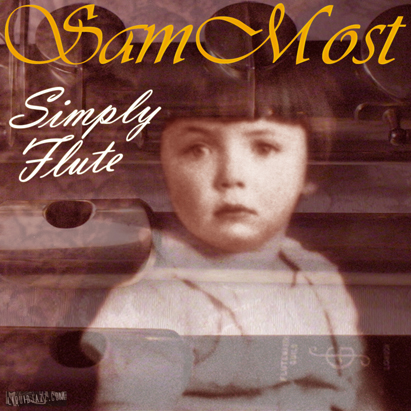1) Devil May Care (Bob Dorough/Terrell Kirk, Jr.) (6:35)
2) Anthropology (Charlie Parker/John Gillespie/Walter Bishop) (5:06)
3) Body and Soul (Johnny Green/Edward Heyman/Robert Sour) (2:40)
4) Manteca (John Gillespie/Gil Fuller/Chano Pozo) (5:25)
5) At the End of the Night (Fernando Gelbard/Chico Novarro) (4:02)
6) My Little Suede Shoes (Charlie Parker) (4:26)
7) Waltz for Debby (Bill Evans) (5:10)
8) The Eternal Triangle (Edward "Sonny" Stitt) (3:45)
9) Falling in Love with Love (Richard Rodgers/Lorenz Hart) (5:24)
10) Sail Away (Tom Harrell) (6:09)
11) But Beautiful (Johnny Burke/Jimmy Van Heusen) (5:37)
12) A Beautiful Friendship (Donald Kahn/Stanley Styne) (6:33)
13) The Song is You (Jerome Kern/Oscar Hammerstein II) (5:50)
Sam Most, C Haynes Flute with a Goodman headjoint; G Artley Alto Flute; C Monnig Bass Flute
Mark Waggoner, Guitar
Benjamin May, Bass
Produced by Fernando Gelbard
Recording Engineer: Rick Luxenberg
Recorded in Beverly Hills, California, December 6 and 7, 2000.
Mixed by Fernando Gelbard and Daniel May, Band Ade Studios, Long Beach California.
Post production by Mark Vincent, Multi Media Music Recording Studios, Hollywood, California
Mastering: Kurt Lundvall, Lundvall Mastering, Jersey City, New Jersey.
Photography: Fernando Gelbard
Production Assistant: Amanda Pelaez
Cover Design: Fernando Gelbard, Luis Siquot, Maria Puga Lareo
Art Direction: Maria Puga Lareo
www.liquidjazz.com
SIMPLY FLUTE
What you have in your hands is an invitation to enjoy the living legacy of one of the authentic innovators in jazz music. Born in 1930, Sam Most's professional career started in the late forties, when he played with the orchestras of Tommy Dorsey, Boyd Raeburn, and Don Redman, gaining experience for his first session as a leader, which would take place in 1953. By then, and although he was equally conversant with the tenor saxophone and the clarinet, he was also a brilliant flutist ¬– later on, the flute would be his main instrument.
Dubbed by legendary jazz critic Leonard Feather as “the father of jazz flute,” Sam was, back in the 50s, one of the first musicians to introduce the flute as a prime jazz instrument, which until then only had, if any at all, a secondary place among wind instruments in jazz instrumentation. Although some early ragtime arrangements included parts for flute and piccolo, the flute, because of its low volume and “thin” sound, was not commonly used in jazz ensembles until the 1920s, and did not truly emerge as a solo instrument until the early 50s.
Already established as a multi-woodwind player, Sam worked largely in different settings from the 1950s onwards, releasing albums as a leader and along with jazz luminaries such as Paul Quinichette, Teddy Wilson, Red Norvo, Louis Bellson and Buddy Rich, to name only a few. Even though he came to be very popular within the jazz scene (a telling fact about this is that, by that time, jazz flute fans were divided into two “rival” factions, supporting either him or the other famous flutist of the time, Herbie Mann), later on Sam moved to LA and mainly worked as a studio musician rarely recording under his own name.
So this is why this album must be fully, doubly celebrated: for the music it features, which is simply beautiful, and because it presents the very “father of jazz flute” in its complete, most lyrical dimension, still burning at the age of 70.
Offering an interesting program which combines be-bop tunes and well-known standards, the album kicks off with pianist Bob Dorough’s classic, Devil May Care, and from the very first notes any doubt regarding Most’s sidemen for this session immediately vanishes. Both Benjamin May on the bass and Mark Waggoner on guitar conform a formidable rhythmic engine, providing the perfect beat for Sam’s melodic inventiveness throughout the entire album. Just as pianists Nat “King” Cole and Ahmad Jamal used to do with their acclaimed trios, here Sam gets rid of any drumming or percussion, and leads the bass and the guitar into a swinging excursion that includes heated numbers like Dizzy Gillespie’s Manteca or Charlie Parker’s My Little Suede Shoes and Anthropology, building a truly contagious, danceable swing (and again, without a drummer!).
Sam’s powerful, at times rasping attack remains as impressive as ever, showing a perfect command of his instrument that enables him to improvise at ease, both in fast and slow numbers.
Calmer moments come, and Sam offers his most gentle side in At the End of the Night (producer Fernando Gelbard’s and Argentinean singer-composer Chico Novarro’s contribution) and But Beautiful, which opens with a heartfelt intro by May playing bowed, cello-like bass at a very slow tempo.
As the music unfolds, more familiar melodies arise; their inner beauty is transformed into something new by these artists’ talent. Indeed, it doesn’t matter that we have already listened to these and the rest of the tunes hundreds of times before. As true creators do, Sam still finds new ways to express himself with originality and spontaneity, delivering meaningful messages through these pieces that form a whole tradition. A tradition that he, certainly, has enormously helped to build.
Miguel Bronfman
Jazz critic for the daily Buenos Aires Herald
Copyright © 2008 LiquidJazz.com All rights reserved.


Simply Flute
by Sam Most
on LiquidJazz.com
05/05/2008
Jazz
